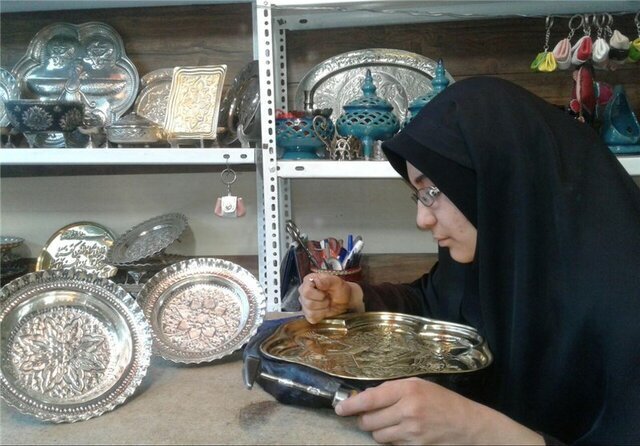Borujerd, city of handicrafts

TEHRAN--Production of various handicrafts, each of which reflects a specific culture and tradition, has made Borujerd one of the most important cities in Lorestan province.
In addition to the traditional nickel silver crafts, Borujerd has long been a fosterer of industries and arts due to its climate, beautiful nature, and urban center. Today, other industries and arts have entered it, some of which have been forgotten for various reasons, ISNA wrote.
Varsho Sazi, the art of making beautiful crafts using nickel silver, is among the oldest traditions in Lorestan province in western Iran.
Since long times ago, the artists of Lorestan, the city of Borujerd in particular, have been earning their livelihood through making various types of handicrafts including rug, jajim, carpet and a valuable art piece deeply rooted in the province’s history called nickel silver crafts.
The crafts used to be among the most profitable careers in Borujerd making up for most parts of the old business in the region so much so that the Borujerd’s name and the crafts were associated with each other.
Through hammering and bending as well as using some simple devices and their own physical power, the artists of Borujerd create some beautiful pieces of art from nickel silver sheets like dining dishes, samovar, sugar dish, caddy, and rosewater sprinkler.
There are various accounts on the history of the nickel silver crafts in Iran. According to one historical account, a small number of Iranian blacksmiths from Isfahan, Borujerd, Dezful and a number of other cities were dispatched to Russia to learn the art of making nickel silver crafts.
Meanwhile, according to some historical books, Iranians used to make nickel silver crafts under the Seljuk and Safavid dynasties and the art reached its climax during the Qajar dynasty.
In some historical documents, a number of Borujerd artists are portrayed while working on nickel silver sheets. They used the sheets to make the basic items for an ordinary life. These artists came to be known as inkwell makers because they were the first artists who made inkwell from nickel silver sheets.
Nickel silver is a white-silver alloy consisting of 20 percent nickel, 35 percent zinc and 45 percent copper. It melts and takes shape easily.
It is imported into Iran from German and Poland. Given its brightness and resistance against decay, nickel silver is also known as German silver.
Varsho Sazi (nickel silverware crafting) was registered as an intangible cultural heritage.
Giveh embroidery, hosiery, carpet weaving, and jajim weaving were also other handicrafts of Borujerd. Coppersmithing was also another thriving profession of Borujerd, and today the name of the order of coppersmiths in the old bazaar (Rasteh Bazaar) of this city vokes the fame of this profession in the mind.
There have been many documents and sayings about the reception of the handicrafts of this city by the elders and tourists. Metal industries include Varsho Sazi (nickel silverware crafting), qalamzani (a type of metalwork art) on varsho, goldsmithing, copper smithing, and knife making.
Carpentry (wood) industries and related handicrafts include making doors in original and different designs, making ceiling decorations of valuable buildings, mosaic, inlay and latticework.
National city of Varsho (nickel silverware crafting)
Mehdi Goudarzi, head of Borujerd Cultural Heritage, Tourism and Handicrafts Department said: “Out of 292 handicrafts covered by Lorestan's Cultural Heritage Department, 39 are native to the city. Currently, about 700 artists and craftsmen are active in various handicrafts.”
He stated: “Currently, 11 handicraft shops and 45 engraving workshops, 45 engraving workshops in the Varsho industry, seven workshops in the field of Varsho Sazi are active in the city, and three handicraft houses including metal, wood and textile have been set up in Borujerd.”
Goudarzi noted that in 2019, Borujerd was registered as a national city of Varsho and some infrastructures have been created for the World City of Varsho (nickel silverware crafting).
He continued that the file for possible world registration of Borujerd’s Varsho is being completed and sent to the ministry, and this file will definitely be sent. Borujerd has the capacity to register this art, because this art is unique and specific to this city, he added. Currently, the Varsho House has been completed and equipped with three floors and nine rooms for the purpose of holding production and manufacturing workshops, training, and an exhibition section for Varsho products.
About craftsmen currently work in the field of Varsho in Borujerd, and Varsho making and engraving on this metal are among the most prominent handicrafts in the city, he concluded.
KD
